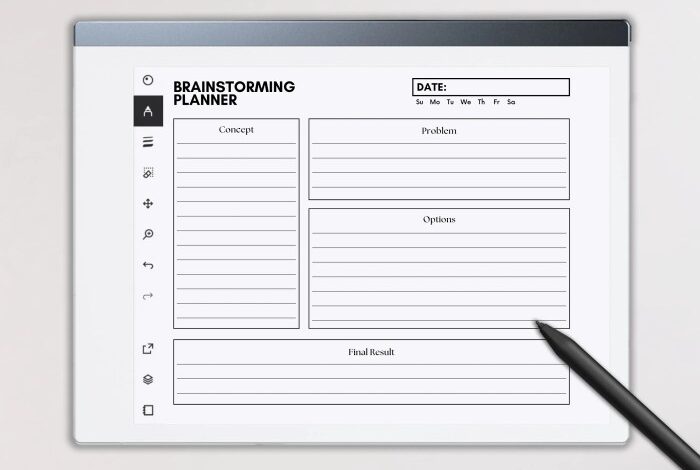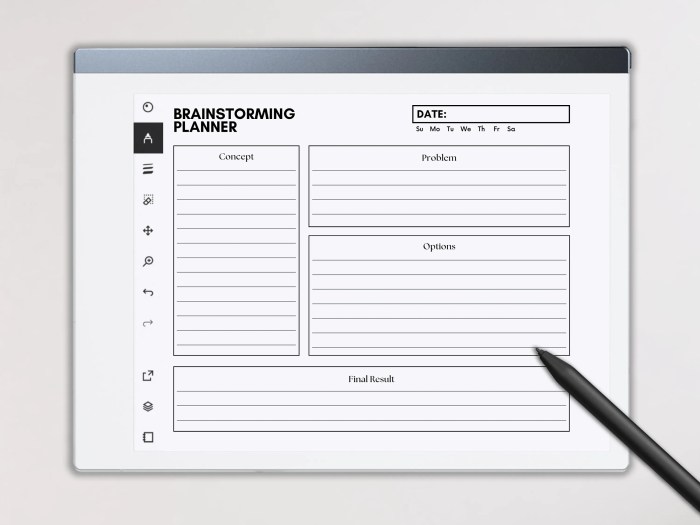
Brainstorming meeting agenda template: A well-structured agenda is key to successful brainstorming sessions. This comprehensive guide provides a detailed template, walking you through defining your meeting, structuring the agenda, facilitating participation, recording ideas, assigning action items, and showcasing various template variations. Whether you’re launching a new product, solving a problem, or improving efficiency, this template will help your team generate innovative solutions.
We’ll explore how to create a visually appealing agenda using HTML tables, ensuring optimal display and engagement. Examples of brainstorming sessions for different scenarios will be detailed, providing practical application of the template.
Structuring the Agenda
Brainstorming sessions are crucial for generating innovative ideas and solutions. A well-structured agenda ensures that the meeting stays focused, productive, and efficient. This section delves into creating effective templates for various brainstorming techniques, from simple open discussions to more structured approaches.A clear agenda provides a roadmap for the brainstorming process. It establishes a shared understanding of the objectives, the techniques to be employed, and the expected outcomes.
This, in turn, empowers participants to contribute effectively and maximizes the potential for generating valuable insights.
Brainstorming Meeting Agenda Template
This template provides a structured framework for a brainstorming meeting, allocating specific time slots for different phases. This allows for a smooth transition between activities and keeps the discussion on track.
- Introduction (5 minutes): Setting the stage for the meeting, reviewing the goals, and outlining the process. This includes defining the scope of the brainstorming session and establishing ground rules for respectful and constructive participation. Participants should be introduced to the overall objective and the specific problem/topic to be addressed.
- Idea Generation (30 minutes): Employing various brainstorming techniques (e.g., mind mapping, SCAMPER) to generate a wide range of ideas. The focus is on quantity over quality at this stage. Encouraging diverse perspectives and refraining from criticism are paramount.
- Idea Refinement (20 minutes): Taking the generated ideas and refining them. This phase involves clarifying concepts, suggesting improvements, and considering potential applications. A discussion about the feasibility and potential impact of each idea is essential.
- Prioritization and Selection (15 minutes): Evaluating the refined ideas based on predefined criteria (e.g., feasibility, impact, cost). Prioritizing the most promising ideas and selecting those that will be pursued further in subsequent stages. This stage requires consensus and objective evaluation.
- Action Item Assignment (10 minutes): Assigning specific action items to individuals or teams, along with deadlines for completion. Clearly defined responsibilities and timelines help ensure accountability and efficient follow-up.
- Wrap-up and Next Steps (5 minutes): Summarizing the key takeaways, highlighting the prioritized ideas, and scheduling the next meeting to discuss the selected ideas or move forward with action items.
Incorporating Brainstorming Techniques, Brainstorming meeting agenda template
Different brainstorming techniques can enhance the idea generation process. Employing multiple methods helps explore diverse perspectives and stimulate creativity.
- Mind Mapping: A visual technique for organizing ideas by connecting them to a central theme. This helps visualize relationships and identify connections between concepts. This can lead to more comprehensive and interconnected solutions.
- SCAMPER: A structured technique to stimulate creative thinking by prompting users to consider modifications to existing products or ideas. It encourages a broad range of possibilities and can help identify innovative approaches.
Facilitating Open Discussion and Idea Generation
An open and inclusive environment is essential for idea generation. This encourages active participation and diverse perspectives.
- Active Listening: Encourage participants to listen attentively to others’ ideas, allowing them to build upon each other’s thoughts and suggestions. This ensures a collaborative and constructive environment.
- Constructive Feedback: Provide constructive criticism and suggestions to enhance the quality of ideas without hindering participation. Focus on improving the ideas rather than criticizing the individuals.
Documenting and Tracking Generated Ideas
Proper documentation of generated ideas is vital for follow-up and future reference. A dedicated system for recording and organizing ideas will enhance future brainstorming sessions and improve team performance.
| Idea | Description | Potential Impact | Priority |
|---|---|---|---|
| Idea 1 | Detailed description of the idea. | High impact on user experience. | High |
| Idea 2 | Detailed description of the idea. | Moderate impact on user experience. | Medium |
Action Item Assignment and Deadlines
A clear system for assigning action items and deadlines ensures accountability and timely progress.
- Designated Owner: Clearly assign ownership of each action item to specific individuals or teams.
- Realistic Deadlines: Set realistic deadlines that allow sufficient time for completion without compromising quality.
Facilitating Participation
Brainstorming sessions thrive on active participation from all attendees. A dynamic environment encourages the free flow of ideas and fosters a sense of shared responsibility in the creative process. This section Artikels strategies for creating a welcoming space where every voice can be heard and valued.
So, you’re prepping for a brainstorming meeting? A solid agenda template is key, ensuring everyone stays on track. Think about how a proactive approach, like PCI compliance offense is the best defense , applies to your brainstorming sessions. Documenting potential risks and proactively planning for solutions, will make your meeting more productive and less stressful.
A well-structured template is your secret weapon for a successful outcome.
Encouraging Active Participation
To foster active participation, it’s crucial to design a process that makes everyone feel comfortable contributing. This involves clear communication about expectations, the use of inclusive language, and the creation of a safe space for risk-taking. Attendees should feel confident that their ideas will be heard and respected, regardless of their background or experience level.
- Establish Clear Expectations: Clearly define the purpose of the brainstorming session and the desired outcomes. Explain the importance of each participant’s contribution to achieving these objectives. This upfront clarity reduces ambiguity and encourages focused participation.
- Use Inclusive Language: Employ language that avoids exclusionary terms or phrases. Emphasize the value of diverse perspectives and encourage open-mindedness. Words like “we” and “us” can foster a collaborative spirit, while language that implies individual competition should be avoided.
- Create a Safe Space: Explicitly state that all ideas, even those that seem unconventional or impractical at first, are valuable. Emphasize that there are no wrong answers in the brainstorming phase. This creates a psychologically safe environment where participants feel comfortable taking risks and exploring unconventional solutions.
Creating a Comfortable Environment
A comfortable environment fosters open communication and reduces apprehension. It’s about creating an atmosphere where people feel safe enough to share their ideas without fear of judgment or criticism. Attendees should feel that their unique contributions are valued and appreciated.
Thinking about a brainstorming meeting agenda template? It’s all about structure and clear objectives, right? But sometimes, the most innovative ideas come from unexpected places. Take North Korea’s 3G experiment, for example – north koreas 3g experiment might be over. This project’s potential end could inspire a brainstorming session focused on alternative technological paths.
Ultimately, a good agenda template helps guide the conversation and ensure everyone’s ideas are heard and considered.
- Establish Ground Rules for Respectful Communication: A set of ground rules provides a framework for respectful and productive discussion. It clarifies expectations regarding tone, language, and behavior, ensuring that everyone feels heard and respected.
- Encourage Active Listening: Explain the importance of active listening to truly grasp the ideas of others. Participants should be encouraged to paraphrase and summarize ideas to ensure understanding and avoid misinterpretations.
- Minimize Distractions: Identify and minimize distractions in the physical environment. This can include turning off mobile devices, creating a designated space free of interruptions, and ensuring the physical setup is conducive to conversation.
Ground Rules for Respectful Communication
Ground rules are essential for maintaining a productive and positive brainstorming environment. They provide a clear framework for how participants should interact with one another and ensure that everyone feels safe and comfortable sharing their thoughts.
Thinking about a brainstorming meeting agenda template? It’s crucial for a productive session. But what if your enterprise data is leaking? A new app, like this one , aims to fix those problems. Understanding how to effectively manage data breaches can be incorporated into your brainstorming meeting agenda template, making the entire process more secure and effective.
| Ground Rule | Description |
|---|---|
| Respectful Language | Avoid using derogatory or offensive language. Focus on constructive feedback and positive interactions. |
| Active Listening | Pay attention to what others are saying and show engagement. Paraphrase and summarize to ensure understanding. |
| Constructive Criticism | Offer feedback in a supportive and helpful way. Focus on the idea, not the person. |
| Respectful Disagreement | Disagreements are inevitable, but express them respectfully. Focus on the reasoning behind the differing opinions. |
| Open-Mindedness | Be open to new ideas and perspectives. Avoid immediately dismissing suggestions without careful consideration. |
Icebreaker Activities
Icebreakers help participants connect and create a relaxed atmosphere. They serve as a springboard for more focused discussions. Effective icebreakers should be brief, engaging, and encourage interaction.
- “Two Truths and a Lie”: Each participant shares three “facts” about themselves—two true and one false. Others guess the lie. This fosters lighthearted interaction and reveals interesting personal details.
- “Human Knot”: Participants stand in a circle, reach out and grab the hands of two different people across the circle. The group then untangles themselves without letting go of hands. This activity promotes collaboration and problem-solving skills in a fun, engaging way.
- “Minute to Win It”: A series of quick, fun challenges, designed to encourage collaboration and teamwork. This is especially good for groups with a competitive edge.
Encouraging Diverse Perspectives
Brainstorming sessions benefit from diverse perspectives. These diverse viewpoints bring a wealth of ideas and potential solutions to the table. By consciously including a variety of backgrounds, experiences, and thought processes, the brainstorming process can become significantly more effective.
- Identify Potential Biases: Be aware of potential biases and actively seek out diverse perspectives. Consider the backgrounds and experiences of attendees and ask for input from underrepresented groups.
- Ask for Diverse Input: Specifically ask for opinions from individuals who may not typically speak up. This might involve directly asking those with different backgrounds or experiences to share their thoughts. For example, “Sarah, what are your thoughts on this?”
- Encourage Participation from All: Create an environment where all voices feel valued and encouraged to participate. Establish clear expectations for respectful communication and create a psychologically safe space for everyone.
Recording and Evaluating Ideas
Brainstorming sessions are powerful tools for generating innovative solutions. However, the effectiveness of these sessions hinges on the ability to capture and evaluate the ideas generated. This section delves into strategies for efficient idea recording and insightful evaluation.
Idea Capture Template
To ensure no brilliant thought is lost, a structured approach to idea capture is crucial. A simple template, easily adaptable to any brainstorming session, can greatly assist. This template should include fields for:
- Idea Statement: A concise description of the idea. This should be clear and understandable without requiring further explanation. A clear and succinct statement will help the team quickly grasp the essence of the idea.
- Originator: The individual who proposed the idea. This fosters a sense of ownership and encourages contributions from all participants.
- Date & Time: Recording the exact time of idea generation can be helpful in recalling the context of the session and the flow of ideas.
- s: Relevant s to categorize the idea later. This allows for quick retrieval and grouping of similar ideas.
- Supporting Notes: Space for additional details, context, or potential follow-up questions related to the idea. This ensures the idea isn’t lost in translation or misinterpretation.
Effective Recording Methods
Efficient recording methods ensure the ideas are accurately captured and readily available for later review.
- Dedicated Note-Taker: A designated note-taker can focus solely on recording ideas, ensuring a high level of accuracy. This person can use a template or a digital tool to capture the ideas in real-time.
- Digital Platforms: Tools like shared documents or online whiteboards allow real-time collaboration and idea capturing. This facilitates simultaneous input and ensures everyone has access to the recorded ideas.
- Audio Recording: Audio recordings can capture the entire discussion, allowing for later review of the context and nuances of each idea. Transcribing the audio recordings can provide a written record.
Idea Organization Template
Organizing the captured ideas facilitates analysis and prioritization. A matrix or table can effectively categorize and group ideas based on shared characteristics or objectives.
| Category | Idea Statement | Originator | s |
|---|---|---|---|
| Marketing Strategies | Develop social media campaign | Sarah | Social Media, Engagement |
| Product Development | Enhance user interface | David | UI, User Experience |
Evaluation and Prioritization Template
Evaluating and prioritizing ideas involves a structured approach to assess their potential value. A scoring system can be employed to assign numerical values based on various criteria.
- Criteria: Define specific criteria for evaluating ideas, such as feasibility, impact, and alignment with objectives. These criteria should be relevant to the specific brainstorming session and align with the overall goals.
- Weighting: Assign weights to each criterion based on its importance. A criterion like “feasibility” might be more critical than “novelty” in certain contexts.
- Scoring: Develop a scoring scale for each criterion. This scale should be clearly defined and easily understood. Ideas can be rated on a scale of 1-5, with 5 being the highest score.
Evaluation Criteria Examples
Different evaluation criteria are applicable based on the nature of the brainstorming session. Examples of evaluation criteria include:
- Feasibility: How easily can the idea be implemented?
- Impact: What is the potential effect of the idea on the desired outcome?
- Alignment with Objectives: How well does the idea align with the overall goals of the project or organization?
- Resource Requirements: What resources (time, money, personnel) are needed to implement the idea?
- Innovation: How novel or groundbreaking is the idea?
Action Items and Follow-up
Brainstorming sessions are only effective if the generated ideas translate into tangible actions. A robust follow-up system ensures that momentum is maintained and that the meeting’s outcomes are realized. This section details actionable strategies for assigning, tracking, and completing action items, ensuring a smooth transition from brainstorming to execution.This section focuses on creating a structured process for translating the brilliant ideas generated during a brainstorming session into practical, measurable outcomes.
By establishing clear action items, deadlines, and tracking mechanisms, we can ensure that the session’s energy doesn’t dissipate and that actionable steps are taken to achieve the desired results.
Action Item Assignment Template
A well-defined action item assignment template is crucial for clarity and accountability. This template should include a designated space for the action item description, the person responsible for the task, a due date, and a method for tracking progress. This ensures everyone understands their role and the expected timeframe.
- Action Item: A concise description of the task.
- Responsible Party: Name of the individual or team responsible.
- Due Date: Specific date and time by which the action item must be completed.
- Status: A field to track the progress of the action item (e.g., To Do, In Progress, Complete).
- Notes: Space for any relevant details or considerations.
Deadline Setting Template
Establishing realistic deadlines is essential for effective follow-up. The template should consider factors like complexity, resource availability, and potential dependencies. A flexible, but well-defined, approach will prevent unnecessary pressure and ensure that action items are completed within a reasonable timeframe.
- Project Scope: Brief description of the project or initiative the action item supports.
- Task Complexity: Estimate of the task’s complexity (e.g., low, medium, high).
- Resource Availability: Identify the resources required to complete the action item (e.g., personnel, budget, software).
- Dependencies: List any tasks that need to be completed before this action item can be started.
- Proposed Deadline: Specific date and time for completion, considering the above factors.
Progress Tracking Method
A consistent method for tracking action item progress is critical. This could involve a shared spreadsheet, a project management tool, or a dedicated communication channel. Regular updates and visibility into the progress of action items foster accountability and allow for timely intervention if needed.
- Shared Spreadsheet: A simple and effective way to track progress, allowing for real-time updates and collaboration.
- Project Management Software: Tools like Asana, Trello, or Monday.com can streamline task management, deadlines, and communication.
- Dedicated Communication Channel: Using a dedicated email thread or a dedicated Slack channel for progress updates.
Follow-up Communication Strategies
Effective communication is key to ensuring action items are completed on time. Strategies include regular check-ins, progress reports, and proactive communication regarding potential roadblocks. Open communication channels encourage timely interventions and reduce the risk of delays.
- Regular Check-ins: Schedule brief check-ins with the responsible party to discuss progress and address any roadblocks.
- Progress Reports: Request periodic progress reports to maintain visibility and proactively address potential issues.
- Proactive Communication: Communicate proactively about potential roadblocks or dependencies that may affect the completion of action items.
Post-Brainstorming Meeting Summary Template
A well-structured summary of the brainstorming meeting is vital for preserving the discussion and ensuring everyone is on the same page. This document should include a recap of the key ideas, assigned action items, and deadlines. This serves as a reference point for future actions and a way to track the progress of the generated ideas.
- Meeting Date and Time: Record the date and time of the brainstorming meeting.
- Attendees: List the names of all participants.
- Key Ideas Generated: Summarize the key ideas and insights from the session.
- Action Items and Assignments: List all action items, their assignees, and deadlines.
- Next Steps: Artikel any follow-up actions required.
Template Variations
Brainstorming agendas are not one-size-fits-all. The optimal format depends heavily on the specific goals and context of the session. This section dives into various template types to cater to different project needs and participant demographics. Adaptability is key to effective brainstorming, and these templates provide flexible structures for diverse scenarios.
Project-Specific Brainstorming Agenda Template
This template is ideal for focused brainstorming sessions around a particular project or product. It ensures all aspects of the project are considered during the brainstorming session.
- Project Overview: Briefly introduce the project, its objectives, and current status. This sets the stage for the brainstorming session, making sure everyone is on the same page.
- Problem Definition: Clearly state the problem the project aims to solve or the opportunity to explore. This clarity helps in focusing ideas on the target goal.
- Brainstorming Session: This section Artikels the core of the session. It includes time allocations for idea generation, discussion, and evaluation. Allocate sufficient time for each stage.
- Idea Prioritization: Establish a structured process for evaluating generated ideas, including criteria for selection and ranking. This avoids confusion and ensures the most valuable ideas receive attention.
- Next Steps and Action Items: Clearly define who is responsible for what, and set deadlines for tasks following the brainstorming session. This ensures a smooth transition to the next phase of the project.
Problem-Solving Brainstorming Agenda Template
This template is useful for brainstorming sessions specifically focused on resolving issues. A clear problem statement is essential to steer the session toward effective solutions.
- Problem Statement: Clearly and concisely define the problem to be solved. Ensure all participants understand the issue before generating solutions.
- Root Cause Analysis: Spend time analyzing the root causes of the problem. This goes beyond symptoms and targets the underlying issues.
- Brainstorming: Focus the session on potential solutions to the identified root causes. Use techniques like “6 Thinking Hats” to encourage diverse perspectives.
- Solution Evaluation: Evaluate the proposed solutions based on factors such as feasibility, cost, and potential impact. This structured evaluation helps choose the most promising solutions.
- Action Planning: Detail the steps required to implement the chosen solution, assign responsibilities, and set timelines.
Brainstorming Agenda for Large Groups
For large groups, structure is paramount. A well-organized agenda ensures efficient idea generation and prevents confusion.
- Icebreaker: Start with a brief icebreaker activity to encourage interaction and collaboration among participants. This helps participants feel comfortable and ready to participate actively.
- Ground Rules: Clearly define the rules of engagement for the session, such as respecting each other’s ideas and avoiding judgment. This ensures a safe space for everyone to contribute.
- Brainstorming Techniques: Include specific brainstorming techniques tailored to large groups, such as round-robin or individual brainstorming followed by group discussion. This ensures a balanced contribution from all members.
- Idea Categorization: Develop a system for categorizing generated ideas, to help manage the volume of input effectively. This helps in organizing and reviewing the ideas.
- Group Discussion and Consensus Building: Designate time for group discussion and consensus building to ensure that everyone feels heard and understood. This is crucial to achieve agreement on the best course of action.
Brainstorming Agenda for Remote Participants
Remote brainstorming requires specific considerations to maintain engagement and participation.
- Interactive Tools: Use collaborative online tools to facilitate brainstorming, enabling real-time idea sharing and feedback. Tools like Miro or Mural can be very helpful.
- Clear Communication Channels: Establish clear communication channels for questions and comments during the session. This is crucial for remote participants to feel involved.
- Structured Icebreakers: Include interactive icebreakers suitable for remote settings, such as online polls or virtual breakout rooms. This helps remote participants feel connected and ready to brainstorm.
- Time Management: Strict time management is even more critical in remote sessions to keep participants focused. Use clear time limits for each segment of the agenda.
- Feedback Mechanisms: Implement feedback mechanisms for remote participants to ensure everyone’s ideas are considered and validated. Regular polls or chat functionalities can help.
Industry/Department-Specific Templates
Different industries and departments may have unique brainstorming needs. Tailoring the agenda is crucial for optimal results.
- Marketing Brainstorming: Focus on customer insights, market trends, and campaign ideas. This session will involve analyzing competitor activities, identifying target audiences, and designing compelling campaigns.
- Engineering Brainstorming: Emphasize technical feasibility, cost-effectiveness, and scalability of solutions. This session should include technical experts to evaluate the feasibility and cost-efficiency of different solutions.
- Customer Service Brainstorming: Prioritize solutions to improve customer experience, enhance support channels, and address customer complaints. This session will focus on identifying pain points for customers and designing solutions.
Visual Representation of the Agenda
A visually appealing agenda is crucial for a successful brainstorming session. A well-designed agenda not only helps participants understand the flow of the meeting but also enhances engagement and fosters a more productive environment. Clear visual cues and color-coding can make it easier for individuals to follow along and contribute effectively.A well-structured agenda, especially for a brainstorming session, should be more than just a list of topics.
It should be a roadmap that guides the group through the process, helping them focus their energy and creativity. Visual aids, such as a clear time allocation and visual representation of the flow, significantly contribute to the meeting’s success.
Visual Agenda Template
This template utilizes HTML tables for a responsive and visually appealing design. The table structure is well-suited for arranging information concisely and clearly.
| Time | Activity | Description | Responsible Person |
|---|---|---|---|
| 9:00 – 9:15 | Welcome & Introductions | Icebreaker activities and introductions for team members. | Facilitator |
| 9:15 – 10:00 | Brainstorming Session – Round 1 | Open discussion on the key problem areas. | All team members |
| 10:00 – 10:15 | Break | Short break for refreshments and relaxation. | Facilitator |
| 10:15 – 11:00 | Brainstorming Session – Round 2 | Focusing on specific solutions for the problem areas. | All team members |
| 11:00 – 11:30 | Idea Consolidation | Discussion on merging and refining ideas from Round 1 and 2. | Facilitator and team members |
| 11:30 – 12:00 | Action Items & Next Steps | Assigning tasks and scheduling follow-up meetings. | Facilitator and relevant team members |
Time Allocation
A clear visual representation of the allocated time for each agenda item is essential. This ensures that the meeting stays on schedule and each segment receives the necessary attention. The example above uses a clear time slot for each activity, which is crucial for time management and maintaining the meeting’s flow.
Color-Coding for Agenda Items
Color-coding different agenda items can significantly improve readability and comprehension. For example, brainstorming sessions could be highlighted in one color, while break times or discussion phases might have a different color.
Visual Representation of Flow
The table structure itself acts as a visual representation of the meeting’s flow. The chronological order of the agenda items clearly indicates the progression of the brainstorming session. This template also helps with a clear understanding of the meeting structure.
Illustrative Examples: Brainstorming Meeting Agenda Template

Brainstorming sessions are crucial for generating innovative ideas and finding effective solutions. These sessions, when structured correctly, can unlock valuable insights and propel projects forward. The following examples demonstrate how to apply a structured brainstorming template to different business scenarios.
New Product Launch Brainstorming Session
A well-structured brainstorming session for a new product launch focuses on defining the target audience, identifying key features, and outlining potential marketing strategies. The session should involve all relevant stakeholders, from product development to marketing and sales. The goal is to generate a wide range of ideas and then refine them into actionable plans.
- Defining the Target Audience: This involves researching demographics, psychographics, and purchase behaviors of potential customers. Understanding their needs and pain points is essential to creating a product that resonates with them.
- Identifying Key Features: A thorough analysis of existing products in the market, competitor analysis, and user feedback can inform the decision-making process. Brainstorming sessions should focus on unique features and value propositions that differentiate the product.
- Outlining Potential Marketing Strategies: Considering various marketing channels, from social media to traditional advertising, is critical for reaching the target audience effectively. The brainstorming session should generate multiple marketing strategies to achieve different objectives.
Improving Customer Service Brainstorming Session
Improving customer service involves identifying pain points, suggesting solutions, and implementing new processes. This session is designed to foster a collaborative environment where employees can openly share ideas for enhancing the customer experience.
- Identifying Customer Pain Points: Collecting feedback from customer surveys, reviews, and support tickets is essential. Analyzing this data to pinpoint recurring issues and customer frustrations will be vital to understanding the problem.
- Suggesting Solutions: The brainstorming session should encourage the team to propose various solutions to address the identified pain points, focusing on efficiency, empathy, and problem-solving. These could include streamlining processes, improving communication, or providing more comprehensive training.
- Implementing New Processes: Once solutions are identified, the brainstorming session should explore the feasibility of implementing them. This includes considering the resources required, timelines, and potential impact on other departments.
Developing a New Marketing Strategy Brainstorming Session
A brainstorming session for developing a new marketing strategy involves analyzing the current market landscape, identifying opportunities, and creating a comprehensive plan. This process is vital for adapting to market trends and achieving desired outcomes.
- Analyzing the Current Market Landscape: This includes analyzing market trends, competitor analysis, and customer preferences. Identifying the market’s current needs and how the company can fill those needs is key to a successful strategy.
- Identifying Opportunities: Exploring new market segments, innovative marketing channels, and emerging technologies is essential for creating a compelling marketing strategy. This involves brainstorming different approaches to reach the target audience.
- Creating a Comprehensive Plan: Once opportunities are identified, the brainstorming session should create a detailed plan that Artikels specific marketing campaigns, budgets, and timelines. This plan should be measurable and trackable to assess success.
Problem-Solving in a Specific Department Brainstorming Session
This session focuses on identifying the root cause of a problem within a specific department and generating effective solutions. It aims to improve efficiency and productivity by identifying bottlenecks and proposing solutions.
- Identifying the Problem: Clearly defining the issue faced by the department is essential. This includes gathering data, analyzing performance metrics, and understanding the impact on overall business objectives.
- Identifying the Root Cause: This involves a thorough investigation into the underlying factors contributing to the problem. Analyzing workflows, processes, and resource allocation is crucial.
- Generating Solutions: The brainstorming session should encourage the team to generate a variety of potential solutions, focusing on both short-term and long-term strategies. This should involve evaluating the feasibility of each solution.
Increasing Efficiency in a Company Brainstorming Session
Increasing company efficiency involves identifying areas for improvement, developing strategies for process optimization, and evaluating the impact of those changes.
- Identifying Areas for Improvement: This involves analyzing current processes, identifying bottlenecks, and evaluating the use of resources. Analyzing productivity metrics and comparing them to industry benchmarks can help identify problem areas.
- Developing Strategies for Process Optimization: The brainstorming session should focus on developing practical strategies to improve workflows, reduce redundancy, and streamline processes. These strategies could include automation, delegation, or re-engineering.
- Evaluating the Impact of Changes: The brainstorming session should assess the potential impact of proposed changes on different departments and stakeholders. Implementing a system for measuring the impact of changes is vital for future improvements.
Closure

In conclusion, this brainstorming meeting agenda template provides a robust framework for productive and innovative sessions. From defining the objectives to recording ideas and assigning action items, the template offers a complete solution. Customize it to fit your specific needs, and watch your team unlock creative solutions. Remember, a well-organized agenda fosters participation, clarifies expectations, and ultimately drives impactful results.
Use this template as a springboard for your next brainstorming session!






